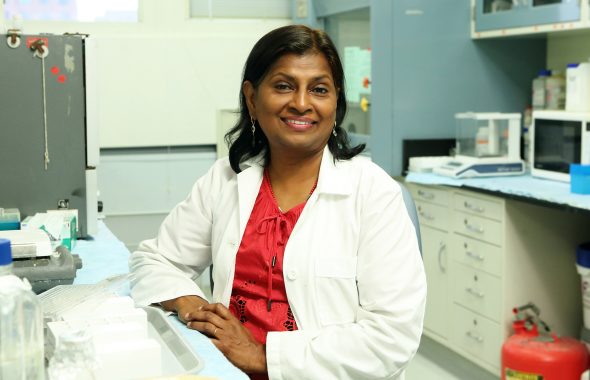University Scholar Anne George
Anne George
Dr. Allan G. Brodie Endowed Professor in the College of Dentistry and professor of oral biology
20 years at UIC
What are your research interests?
Formation of calcified tissues is a well-regulated process balanced by promoters and inhibitors of biomineralization. Interruption of this balance in bone, dentin and other mineralized tissues results in a wide range of pathologic conditions. My lab has been instrumental in identifying a family of dentin matrix protein that is involved in bone and dentin mineralization. Therefore, our research interests on biomineralization are from the perspectives of dentistry, as in dentin regeneration; of basic research, as in understanding the role of proteins in forming a calcified tissue; and lastly, translational research, as in development of biomineralization related protein-based biomaterials for bone and dentin regeneration. Overall, our goal is to elucidate the biological strategies used by nature in biomineralization.
How did you become interested in these topics?
During my postdoctoral work at Northwestern University, I was introduced to the role of proteins and how they regulated and fine-tuned the formation of mineralized tissues. I was fascinated with how nature uses a toolbox containing myriads of proteins and metals for sculpturing complex crystalline and amorphous calcified structures for diverse uses. The size and shape of the mineralized structures were fascinating and even intriguing was the role of proteins in defining their morphology. This initial interest became the focus of my lab. With the advancement of tissue-engineering, I became interested in the translational component of our basic science studies and hence, was interested in tissue regeneration. Further, going to specialized meetings focused on understanding the basic understanding of the mechanisms involved in the formation, maintenance, and repair/regeneration of mineralized tissues and ectopic mineralization of tissues further advanced my interest.
What do you teach?
I teach about the structure and function of hard tissues such as bone, dentin and enamel to the dental students. At the graduate school, I teach about stem cells in the tooth and their use in making a tooth and regenerating lost tissues in the dental and craniofacial complex. Lastly, I mentor Ph.D. students and this I would consider as “personalized” teaching.
How do you balance teaching and research?
Most of the courses are team-taught by several faculty members; therefore, it is a shared effort and the burden is comparatively less. This gives me time to focus on several research projects in the lab and guiding and directly supervising a busy laboratory comprised of dental students, DMD-Ph.D. students and post-doctoral students.
What’s your advice to students who want to focus their future careers on research?
Research is fun as it is a discovery process; however, there are frustrations along the way. It is a bittersweet experience. Perseverance and patience should be the goal to combat frustration, and at the end of the day, it will be a successful and satisfying experience.

